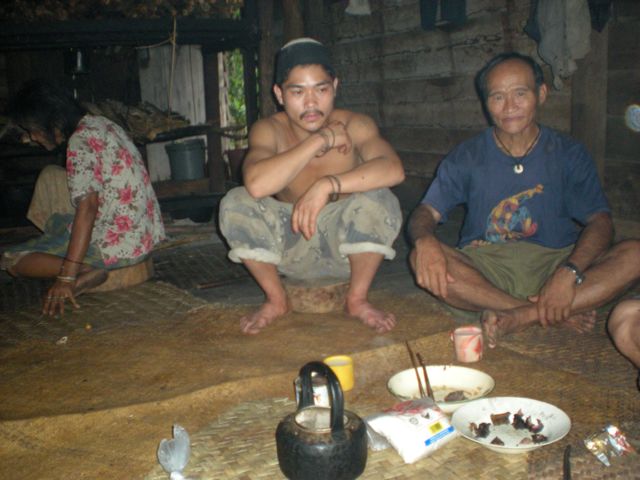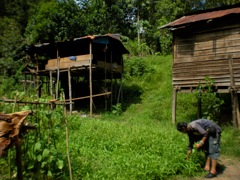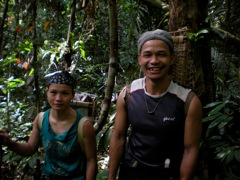|
|||||||||||||||
History and Culture of Pa Tik "A" & Pa Tik "B"
 Ba' Tik "A" Location. Ba' Tik "A" is located west of the Pulong Tau National Park, slightly above the confluence of the Nyela and Tik. It is about two kilometers away from the Park. The village is nestled on a large padang (open field) used as a helicopter landing pad as well as a soccer field for British soldiers during Konfrontasi. A perfect spot, its surroundings are picturesque. The settlement is within the area of the former Kelabit village of Pa' Tik. Population. Ba' Tik "A" is a small settlement comprising 8 households and a population of 35 people. Out of this population, four are Penan from other villages: 2 from Long Kerong, one each from Long Kawi and Ba' Ajeng. They came to Ba' Tik "A" following marriages with the local people. When they first established a settlement here, the group comprised four bands of former nomads, each group made up of members closely related by blood or marriage. Over the years, three groups left the settlement, reverting to nomadic life. The remaining group under the present headman, Melai Na', also split into three groups, leaving the present population of a mere 35 individuals. Figure 5 shows the age structure of the Penan settlement of Ba' Tik "A." Education. Eight of the children are currently attending school in Bario, four in the primary school and four in the secondary school. Six of the adults in their 30s and 40s have had primary education. Two individuals in their 20s and 30s attended the adult education classes organized by the Sidang Injil Borneo Church. This is a continuation of the adult education program introduced by the Borneo Evangelical Mission. History. The Penan of Ba' Tik "A" claim that they have always lived in the Kuba'an and its tributaries, the Rekidah, Nyela, Lobang, and Laleh. But they also moved into the Magoh, Tutoh, Selungo, and Akah. They even crossed the Baram River into the Silat, Selio, and as far as the Usun Apau in Western Penan territory. The headman talked fondly of meeting Western Penan with whom Eastern Penan seldom meet. Even though they traveled far, they would return to the place they call their ancestral land, tana' pohoo. Around the time of the Brunei Rebellion in December 1962, they were invited by the Kelabit headman of Pa' Tik, Lupong Bala, to settle near the Kelabit longhouse. The Penan built their huts on the true left bank of the Nyela, opposite the Kelabit longhouse. At the time the Kelabit were on the verge of moving to Bario. The majority of the Pa' Tik Kelabit are now settled at Arur Dalan, Bario. The Penan headman recalls that there were only two resident Kelabit families when they built their huts. When they first settled at Ba' Tik, they comprised four nomadic bands. Leaders of these bands were Wee Salau, Kurau Kusin, Pelisi Agan Jeluan, and Melai Na'. Except for the band under Melai Na', the other bands were all from the Magoh. After a few years of living in the Ba' Tik area, Wee Salau, Kurau Kusin, and Pelisi Agan Jeluan led their bands back to the Magoh. They said that they had to go back to their own place, their ancestral land, tana' pohoo. Pelisi Agan Jeluan took his group back to the Upper Magoh, Wee Salau and Kurau Kusin brought their own groups back to the Lower Magoh, close to the Mulu National Park. Sometime in the early or mid 1990s, a splinter group led by Kuya Akeh moved up the Nyela to farm around the Long Lobang area. At that time they moved back and forth between Ba' Tik "A" and Long Lobang, but by 2001 the group spent more time at Long Lobang than Ba' Tik "A." In 2004 a new longhouse was built for them, and this made their stay in Long Lobang permanent. In 2001, Melai's son, Samuel, moved up the Tik River to establish another settlement called Ba' Tik "B" following a disagreement between them over the marriage of the latter to a nomadic Penan girl. Today, Ba' Tik "A" comprises only eight families with a population of 35 people. Contact with Outsiders. The Penan of Ba' Tik "A" had a good relationship with the Kelabit of Pa' Tik. They traded with the Kelabit and were often guests. They also traded with the Kenyah, Kayan, and Berawan whom they met at trade meetings in the Selungo, Layun, and Malinau. It was during these trade meetings that they also had contacts with various colonial officers. Melai's group is perhaps the only Eastern Penan from the Tutoh area to have lived with the Western Penan. Christianity. As regular guests of the Kelabit of Pa' Tik, the Penan followed the Kelabit to attend church services in the village. Over the years they realized that they have become Christians unconsciously, conducting their own payer meetings. The Penan take Christianity seriously and use it as a guiding principle in their lives. Settlement. Ba' Tik "A" is a perfect site for a village. It is unfortunate that not many Penan live here. The headman extended an invitation to the semi-nomadic Penan of Long Tah to join him, but their reply has always been: "give us time to think about it." He is also not happy that his own son left the village to form a small settlement up the Tik River at Ba' Tik "B." He is hoping that he will return one day to Ba' Tik "A" with the people of Ba' Tik "B", as the place they occupy is located in a narrow valley without room for village expansion. Farming. They have been planting hill rice and cassava since the early 1960s and claim they have enough rice to last them from one harvest to the next. Like the other settled Penan in the area, they rotate their food around rice, cassava, and sago. The forest is still important to the Penan, and they go there every other day to hunt, process sago, and collect rattan, fruit, and vegetables. Income and Employment. There is no cash employment in the area. Although there are a few nearby logging companies, they are not interested in working with them. During the gaharu boom, they made quite a lot of money, but this resource is now difficult to locate. To earn a bit of cash, the few young people in the settlement go to Bario to look for work with Kelabit families. Houses. Most of the families live in single houses built by the British Army during Konfrontasi. The headman's house is still in good condition. On the hill slope leading to the padang where the main village is located are several empty houses left by the Penan who now reside at Long Lobang. They are thinking of building new houses. Views on Timber Blockades. The Penan of Ba' Tik "A" say that putting up a blockade is a waste of time, but if they don't do anything they have nobody to blame other than themselves for not standing up for their rights. They say that when the loggers come in they normally tell them the "sensitive" areas to avoid. When this is not adhered to they go to see the company manager or lodge a complaint at the District Office, Marudi. If no action is taken, they go to Shabat Alam Malaysia (SAM) to get help to write a letter of complaint to the highest State authorities. When all fails, they have no other choice but to erect a blockade or a series of blockades along the timber road. Views on the National Park The villagers say that the Pulong Tau National Park is a good idea. They look at the Park as a way to prevent loggers from destroying the environment. It protects the land, conserves flora and fauna, and prevents landslides and pollution of rivers and streams. The Penan say that they will exercise the right of access to the Park with care. They have been living in the forest since time immemorial and know how to look after it. Views on One Big Settlement. The headman says that the idea of one big settlement for the Penan around Pulong Tau National Park is good, but doubts whether it is achievable. if there is a serious move to regroup Ba' Tik "B" Location. Ba' Tik "B" is located on the true left bank of the Tik River, one and a half hours' walk from Ba' Tik "A" and about one kilometer from the National Park. Population. Ba' Tik "B" comprises nine households and a population of 31 people. Except for the headman, Samuel Melai, and a Berau Dayak from East Kalimantan, the remaining group members were recently nomadic. During my visit to the settlement there were five people at home: the headman, his wife, their niece, the Berau Dayak, and another fellow villager, Pase Tingang. The rest of the villagers were in the forest processing sago or collecting rattan. Of the nine households, six are offshoots of one family, that of Padeng Sega and his wife Runan Tingang. Padeng and Runan have five children with their own nuclear families. An Indonesian Dayak from Berau is married to one of their daughters. Their son, Dawat Padeng, is married to a Penan from Ba' Adang in the Limbang District. Another Penan from the Adang is married to the granddaughter of Padeng and Runan. In fact, everyone in the nine households is closely related by blood or marriage. Education. Of the 11 people between the ages of 5 and 19, 5 are attending school. All the 5 pupils are enrolled in the government primary school at Bario: 2 in Primary Two, I in Primary Four, 1 in Primary Five, and 1 in Primary Six. Four individuals, 2 males and 2 females, between the ages of 30 and 44 have formal education at the primary level. Two individuals, both female, attended the Sidang Injil Borneo Adult Education classes and are able to read the Bible in Penan. Only two adults have formal education up to the secondary level: the headman, Samuel Melai, and the Berau Dayak from East Kalimantan. History. The people of Ba' Tik "B" are from the family of Padeng Sega and his wife Runan Tingang. In the head count I did for nomadic Penan in 1990, I found Padeng's family among the group of nomadic Penan, under the leadership of Bala Tingang, then foragimg in the general area of Kuba'an. About twelve years ago, the headman, Samuel Melai, then living in Ba' Tik "A," married one of Padeng's daughters, Ganit Padeng. Samuel persuaded his father-in-law and his children to settle down. In 2001, they established a settlement on the Tik River, with Samuel as its headman. They grew cassava and planted hill rice on temuda left by the Kelabits who had moved to Bario in the early 1960s. Contact with the Outsiders. The settlers of Ba' Tik "B" are a part of groups of Penan that occupied the Kuba'an since time immemorial. The story of their contact with neighbors and the outside world is similar to the other groups mentioned earlier. Members of the group have traveled widely in the upper Tutoh, Akah, and Selungo, but consider the Kuba'an their ancestral land. Christianity. They became Christians through contact with the Kelabits who used to live at Pa' Tik. Settlement. The settlement is located in a narrow valley surrounded by steep hills. On the opposite bank from the settlement is a very steep hill, where the footpath to Bario snakes its way along the ridge. Farming. The villagers grow both cassava and hill rice, but sago is still preferred by the older folks. The headman says that when they take good care of their farms they normally get a good harvest. But when the villagers spend more time in the forest hunting, looking for rattan, or processing sago, neglecting their farms, then they don't get a good harvest. He says that this is not of great concern to the villagers or him as there is plenty of wild sago, and also cassava to fall back on in times of rice shortage. They raise chickens, but the majority of the people in the settlement do not eat them. Some of the chickens are sold to the timber camp at the mouth of Kuba'an River. Income and Employment. There is no cash employment. Gaharu was the main source of cash income, but this resource is now difficult to locate. There is no market for rattan mats and baskets. If they want to earn some money, they go to Bario to look for work with Kelabit families. During the past four years, a few people have been employed by reseachers as guides, informants, and porters. Houses. During my visit, I saw four houses. Some families are sharing houses. All the houses were built by the Penan themselves. The houses look solid, but are poorly maintained. Views on Timber Blockades. Speaking on behalf of his community, the headman, who I found to be an amiable person, cordial and knowledgeable on local matters, said that the Penan of Ba' Tik "B" have taken an active part in timber blockades in the Baram and Limbang Districts. Logging, as mentioned earlier and elsewhere (see also Brosius 1991, 1993, 1997, 2006, 2007), destroys food resources such as sago, the staple food of most Penan, rattan and other essential items; causes stream and river pollution; and felled tree branches obstruct pathways in the forest, making it difficult walk and locate resources. It is for these reasons that the Penan have put up blockades against logging operations in various parts of the Baram and Limbang Districts. For putting up these blockades, the Penan have been labelled "trouble-makers," "anti-development," etc. The headman said that the Penan do not deserve these labels; they are not opposed to logging per se, and recognize the rights of timber companies to harvest timber. He insisted that, by the same token, the authorities and timber companies should recognize the rights of the Penan to subsist on the forest. When the loggers bulldoze their way onto people's land as if nobody lives off the area, the Penan consider this not only insensitive to the rights of others, but mean and inconsiderate. The Penan of Ba' Tik "B," like other Penan in the upper Baram area take the view that blockades are an expression of frustration and helplessness. They also express their determination to defend their way of life. As long as their rights are not recognized, they intend to continue to press for their recognition. Views on the National Park. The headman said that as far as the people of his village are concerned, they are happy with the idea of turning the area into a national park. They view this as a positive way to prevent logging operations in the area. Although he and the villagers may not understand the detailed concept of a national park and what conservation means, from what they had heard, the idea is generally consistent with how the Penan people relate to the forest. Views on One Big Settlement. The headman felt that one big settlement for the Penan around the Park is not practical. He personally felt that the three settlements, Long Lobang, Ba' Tik "A," Ba' Tik "B," should remain where they are. After all, these settlements are not far apart, with only a one-hour walk between them. He said that the priority should be to encourage the three semi-settled groups to settle down with the existing settled Penan, the Ba' Medamut group to settle at Ba' Tik "B," the Long Tah group at Ba' Tik "A," and the Long Anying group at Long Lobang. Tama Abu Expedition Photos Historical Events From: Mountains of Malaysia: a practical guide and manual. 1857 ~ Spencer St. John makes first recorded attempt by outsider to climb Mulu, but only reaches Banarat.
 BBC News Archive Small groups of nomads move through a land of dense forest, narrow steep-sided valleys and fast flowing streams in the north-east of the state. Penan material culture is changing.... Borneo Post Oct 7, 2009 ...THE Penan community is back in the news. A week ago, all hell broke loose when the much anticipated report by the National Taskforce on the Investigations on Allegations of Rape of Penan Women was circulated on the Internet. The... Penan Proclaim Peace Park on Native Land Set for Logging Nov 29, 2009 ... The Penan Peace Park area is fully concessioned for logging by the ... habitat was then and still is being destroyed by the timber industry. ... Friends of the Penan In the Penan language there are forty words for sago palm, and no words for goodbye, or thank you - or thief. The Penan view the entire rainforest as their home... |
|||||||||||||||
|


